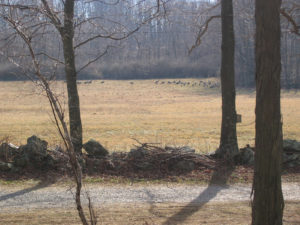The Repopulation of Turkeys in Maryland
by Hayden Spalding
Despite the abundance of wild turkeys that currently reside in Maryland, before the late 1960s, turkeys could not be found in Maryland and many other states. Turkeys were native to Maryland until the colonization of North America, throughout which native turkeys were overharvested and decimated. It wasn’t until the late 1960s when the Department of Natural Resources (DNR) started a program to revitalize the population of turkeys in Maryland that turkeys once again spread throughout the state.
Before DNR took part in restoring the population of turkeys to Maryland, turkeys could only be hunted in Western Maryland, where they were raised and released for sport. This original practice proved to be too expensive to be practical. Maryland’s DNR took steps to remedy the decline of the population in the state by trapping wild turkeys in populated states and releasing them in unpopulated states. For example, turkeys that were trapped in West Virginia were released into the Catoctin Watershed in Frederick County. Twelve turkeys were first introduced and monitored for two years. The relocation proved to be a success, and the population of turkeys in Frederick County expanded. After the first two years, twelve more turkeys were released to increase the reproduction further. DNR created the population of turkeys seen today through the trapping and transplanting of those few turkeys in the late 1960s.
The first official Maryland turkey season was held in 1973. Gobblers, or mature male turkeys, were the only turkeys allowed to be harvested during the season, and the season was ultimately a success. Seminars about the hunting and conservation of turkeys were held at Frederick Community College to educate the public of their new opportunities with the newly developed population. The National Wild Turkey Federation (NWTF) was formed in 1973, and has since supported the conservation and healthy harvesting of the birds throughout Maryland and other states. Our local Monocacy Valley Chapter of the NWTF hosts meetings at the home of Thurmont residents, Gene and Shirley Long. If you would like to become a member with other sportsmen, women, and youth who care deeply about our natural resources and advocate for programs of conservation, please call Secretary Shirley Long at 301-898-7004 or President Russ Leith at 443-677-3669. Current programs include a Mentored Hunt Program, National Archery in the Schools Program, and Farmers and Hunters Feeding the Hungry.
Frederick County was the first county of many to receive the transplant of turkeys from other areas. Today, every county in Maryland is populated with turkeys. Every state, with the exception of Alaska, has a population of trapped and transplanted turkeys due to conservation efforts. Robert Abraham, Sr., a retired regional wildlife manager for the State of Maryland, who was involved in the original trap and transplant program, along with State employees, Buddy Halla and Joe Shugars, said, “It was a conservative effort of many states to get turkeys from one another.” The trapping and transplanting of turkeys has not only rejuvenated the population of turkeys, but expanded the population of them to record highs and created an ongoing heritage.
Maryland’s spring wild turkey hunting season will take place from April 18 to May 23, 2018. Junior Hunt days take place on April 14 and 15. Maryland also has a fall and winter wild turkey season. Check out dnr.maryland.gov for more information.

A large flock of turkeys graze in a field.
Photo by Barbara Abraham

